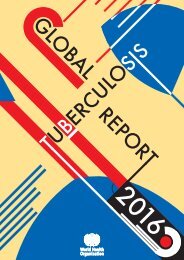patients
DNDi_AR_2015
DNDi_AR_2015
You also want an ePaper? Increase the reach of your titles
YUMPU automatically turns print PDFs into web optimized ePapers that Google loves.
Almina, a mycetoma patient, showing her lesions to Prof Fahal and his team at the Mycetoma Research Centre, Sudan.<br />
› Mycetoma is a truly neglected disease on every level.<br />
Although many suffer from this devastating infection, the<br />
global burden of disease is unknown, as those affected<br />
live in remote villages in<br />
the tropics and subtropics<br />
where there is no disease<br />
surveillance. The route<br />
of transmission is also<br />
unknown, and although it<br />
is thought that the infection<br />
may come from the<br />
soil or from animal dung,<br />
entering the body after the skin has been pricked, by a<br />
thorn for example, there have been no comprehensive<br />
studies to prove this theory.<br />
Newly recognized<br />
as a neglected<br />
disease by WHO<br />
Mycetoma was included in the official list of Neglected<br />
Tropical Diseases during discussions at the World<br />
Health Assembly in May 2016 – the 18th disease to be<br />
included – giving the disease<br />
the political prominence<br />
it so desperately<br />
needs. Such an important<br />
step will allow governments<br />
as well as other<br />
funding bodies to consider<br />
providing resources to set<br />
up research programmes<br />
for the development of new treatments and diagnostics<br />
to combat the disease.<br />
MYCETOMA<br />
What are the current treatments and their limitations?<br />
There are two groups of microbial agents which cause disease. Actinomycetoma – the<br />
form caused by filamentous bacteria (actinomycetes) – responds well to antibiotics<br />
(amikacin and co-trimoxazole) and has a 90% cure rate. However eumycetoma – the fungal<br />
form – develops into a chronic skin infection which, without treatment, invades the<br />
surrounding tissue and bone. Children and young adults, particularly men working<br />
outdoors, are most at risk.<br />
Early treatment has a higher chance of being effective, but <strong>patients</strong> live a long way from<br />
health centres and tend to present with advanced disease, if at all, by which time<br />
antifungal cure is only 25-35% effective. Treatment is most often followed by surgical<br />
removal of the remaining mass and there is a high chance of recurrence, often leading to<br />
multiple amputations and ultimately the loss of entire limbs, with the associated risk of<br />
complications and death. Current antifungals are expensive and cause serious side<br />
effects, and an effective, safe, and affordable curative treatment for use in rural settings<br />
is desperately needed.<br />
Ketoconazole and itraconazole are the antifungal agents that are currently in use, however<br />
these have serious side effects. Concerns about liver toxicity have lead the FDA and EMA<br />
to restrict the use of ketoconazole. Both the duration (twelve months) and cost of<br />
treatment are significant barriers to access for <strong>patients</strong> and health authorities in endemic<br />
areas, and as a result drop-out rates are high: at 10,000 USD per annum, the treatment<br />
represents between 50-100% of the average annual wage of <strong>patients</strong>.<br />
A stigmatizing<br />
disease<br />
that causes devastating<br />
deformities, often resulting<br />
in amputation and morbidity.<br />
Basic epidemiological<br />
information<br />
is missing for this very<br />
neglected disease.<br />
The causative organisms<br />
of mycetoma are<br />
endemic in tropical<br />
and subtropical areas<br />
of the ‘mycetoma<br />
belt’.<br />
WHAT IS DNDi DOING TO ADDRESS UNMET TREATMENT NEEDS?<br />
Recognizing an opportunity to test the effectiveness of fosravuconazole in treating mycetoma after experience with this drug as a<br />
Chagas agent, DNDi included its clinical testing for the disease in its Business Plan 2015-2023 as a short-term, pragmatic, miniportfolio<br />
approach, and in 2016 will begin a clinical study in partnership with the Mycetoma Research Centre in Sudan.<br />
DNDi Annual Report 2015 › 51



